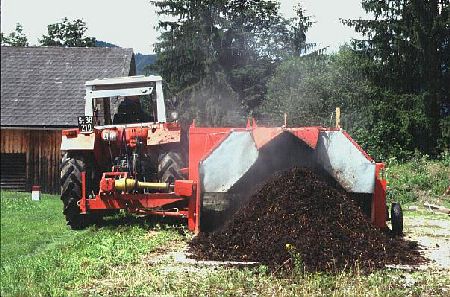In addition, individual test elements from the plant cultivation experiments were examined on a lysimeter system with regard to liquid nutrient losses.
The arable part of the compost project consisted of a combined fertilization/crop rotation experiment in which five different crops (silage maize, spring barley with clover seed, clover grass, potatoes and spring rye) were grown annually. The fertilizer variants were stable manure compost, rotted manure, both from tethered housing, liquid manure, a complete mineral fertilizer and a PK variant. In the grassland trials, in addition to yield performance, particular attention was paid to the effectiveness of the compost nitrogen or the entire compost system.
During composting, a reduction of around 58% in fresh matter was calculated. Around 39% of nitrogen was lost, over 95% of which were gaseous losses. In the case of rotted manure, the fresh mass was reduced by around 35% and the nitrogen by a good 30%. Representative sampling from the heap to chemical digestion caused major problems. Using an emissions measurement room, the Institute for Agricultural, Energy and Environmental Technology at the University of Natural Resources and Life Sciences measured only 14.5% gaseous nitrogen losses during the composting process.
The nutrient losses due to seepage juices during both composting and storage of manure were low in relation to the content values in the manure. One to a maximum of four percent of the total nitrogen content in the compost and manure piles was lost through seepage, around 80% of this in the first three to four weeks of storage or treatment.
There were clear differences in the yields of arable crops between complete mineral fertilization and PK fertilization, but only very small differences between compost and rotted manure variants. In the case of silage maize, nitrogen fertilization was necessary in order to achieve reasonably good fresh and dry matter yields.
The situation is completely different with grain. Here, complete mineral fertilization often led to heavy storage, which was reflected in very low grain yields on the one hand and poor grain quality on the other. The NPK variant was also superior to the other types of fertilizer for potatoes; For clover grass, the compost variant was at the top of the table.
No major changes could be detected on the ground based on various soil parameters. The study of the aggregate stability of the soil yielded very high values overall, but showed a certain superiority of organic fertilizers such as compost, rotted manure and liquid manure compared to mineral fertilizers.
In principle, this experiment demonstrated the good applicability of compost and rotted manure to all arable crops, even if the nutrient effect on silage maize and potatoes without mineral supplementation is inferior to purely mineral fertilization.
In the case of the grassland variants, the high N efficiency of the compost variants in this experiment was striking, although this was surprising given the exclusively organically bound N content.
The decisive factor for the high system efficiency was certainly the sufficient PK supply that was well tailored to the yield, which ensured a correspondingly high legume content. This subsequently improved the N supply and thus also the yield.
With regard to the amount of compost nitrogen taken into account, the previously used value of 0.70 was confirmed from the test results collected here for grassland.
The lysimeter tests once again showed the positive effect of permanent vegetation on groundwater protection. Overall, the level of leaching was low; in 1997, with the highest annual rainfall, the highest annual value of nitrate was measured at 57 kg/ha under the winter roe and compost fertilization variant. All grassland variants remained below 30 kg nitrate-N/ha for all nine trial years, even with a high liquid manure application of 3.0 GVE/ha.
Solid manure composting is and will remain a process for treating manure that is only used when large amounts of straw from animal husbandry systems in grassland areas have to be processed, arable land is not suitable for processing fresh manure or liquid manure (heavy, humus-poor soils) or additional organic waste products from the Agriculture must or can be processed. The relatively high level of work required is too far ahead of the many positive effects of composting for a comprehensive composting system made from stable manure to be possible.







